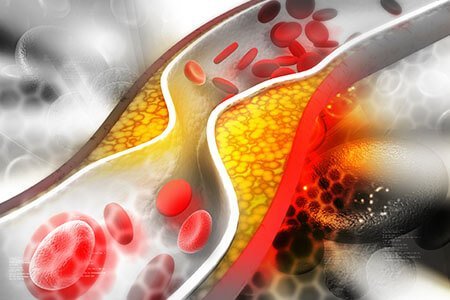Arrhythmias or irregular heartbeats
Its types, causes, symptoms, diagnosis, and treatments
Things you need to know about arrhythmias or irregular heartbeats
What is heart arrhythmia?
The human heart is made of four sacs or chambers. The upper two are known as atria and the lower two as ventricles. A normal heart beats at a rate of 60 to 100 times per minute to circulate blood. The normal rhythm or beating of the heart is controlled by two distinct bunches of nerve cells called the Sino-Atrial (SA) node and the Atrioventricular (AV) node.
Arrhythmias, sometimes known as dysrhythmias, are disorders of electrical impulses causing the heart to beat irregularly or too fast/slow.

Blocked arteries cause arrhythmias
What are the symptoms of arrhythmia?
Sometimes arrhythmias may have no sign and symptom. However, some noticeable symptoms are:
- Chest pain
- Dizziness
- Fainting/syncope
- Feeling of a slowed heartbeat
- Feeling of pounding/ racing heartbeat
- Fluttering in chest
- Shortness of breath
- Sweating
If these symptoms appear suddenly, or frequently, one should visit a cardiologist as soon as possible.
What are the causes of arrhythmias?
Arrhythmias may be caused due to many factors like:
- Blockage of arteries in the heart
- Certain medications
- Cardiomegaly or enlarged heart
- Diabetes
- Disorders of the thyroid
- Drug abuse
- Excessive intake of alcohol or caffeine
- Genetics
- High blood pressure
- Ongoing heart attack
- Scars in heart tissue due to previous heart attack, congestive heart failure etc
- Sleep apnoea
- Smoking
- Stress
- Aging
- Abnormalities of heart muscle
What are the different types of arrhythmias?
Arrhythmias are classified on the basis of their origin and their effect on the speed of the heartbeats. They include:
- Tachycardia or Palpitations: A fast heartbeat, usually >100 beats/min, at rest
- Bradycardia: A slow heartbeat, usually <60 beats/min, at rest
Exercise and physiological phenomena can induce tachycardia/bradycardia unrelated to heart disease.
Tachycardia of atria
Tachycardias that arise in the atria include:
- Atrial fibrillation
- Atrial flutter
- Supraventricular tachycardia
- Wolff-Parkinson-White syndrome
Tachycardia of ventricles
Tachycardias that arise in the ventricles include:
- Ventricular tachycardia
- Ventricular fibrillation
- Long QT syndrome
Bradycardia:
Some common types of bradycardias include:
- Sick sinus syndrome
- Conduction block
Premature heartbeats or premature ventricular contractions
It is an extra beat in the normal sequence of heartbeats. A premature beat can sometimes lead to an arrhythmia in people with existing heart disease.
How is arrhythmia diagnosed?
Cardiologists diagnose arrhythmia by:
- Taking a detailed medical history and conducting a physical examination
- Ordering investigations pertaining to risk factors like thyroid
- Conducting tests like:
- – Electrocardiogram (ECG)
- – Holter and Event monitor
- – Echocardiogram
- – Implantable loop recorder
Sometimes the cardiologist may also advice:
- Stress test
- Tilt table test
- Electrophysiological testing and 3D mapping

How is arrhythmia diagnosed?
How is arrhythmia treated?
A Cardiologist may advise the treatment for arrhythmias depending upon the patient’s overall health, the type and severity of arrhythmia.
Treatment of bradycardia: Bradycardia is treated with implantation of a pacemaker, which is a small device that generates electrical impulses to stimulate the heart.
Treatment of tachycardia: This includes procedures like:
- Cardiac catheter ablation: Scar or destroy the tissue where disturbing electrical signals are generated
- Vagal manoeuvre: Particular movements like holding breath and straining to affect the vagus nerves
- Medications
- Cardioversion (normalizing heart rhythm) by procedure or medication
- Implantable devices like Pacemaker or ICD (Implantable cardioverter-defibrillator)
Surgical treatments: Surgery may be required in some patients. The common surgical procedures include:
- Maze procedure: Cuts or incisions are made in the atrium to create a pattern or maze of scar tissue.
- Coronary bypass surgery: This procedure may help to improve the blood flow to the heart in cases with arrhythmias and blockage of arteries.

Timely treatment can offer better outcomes for arrhythmias
How can arrhythmias be prevented?
Lifestyle changes that help to reduce the risk of heart disease also help prevent arrhythmias. Some of these measures include:
- Avoiding self-medication
- Avoiding too much alcohol, caffeine, and smoking
- Taking a healthy and balanced diet
- Indulging in regular physical activity
- Maintaining a healthy weight
- Stress management
What is the cost of treatment for arrhythmias?
Cost of the treatment varies depending on the mode of the treatment and the patient’s overall health. Furthermore, the following factors will affect the overall cost:
- Underlying cause and its management
- Necessity of hospital admission in ICU or ward, number of days, medications and additional investigations
- Cardiac pacing procedures and pacemaker costs
- Surgeries
- Requirement of advanced medical services like cardiac ICU/OT and specialists – cardiologist or cardiovascular surgeon
To know more about arrhythmia and its management, you can request a callback and our arrhythmias or irregular heartbeats specialist will call you and answer all your queries.
Interesting blogs related to arrhythmias and other heart conditions:
References
- U.S. National Library of Medicine. Arrhythmia. Available at: https://medlineplus.gov/arrhythmia.html. Accessed on February 23, 2018
- Mayo Clinic. Heart Arrhythmia. Available at: https://www.mayoclinic.org/diseases-conditions/heart-arrhythmia/symptoms-causes/syc-20350668 Accessed on February 23, 2018
- National Heart, Lung and Blood Institute. Arrhythmia. Available at: https://www.nhlbi.nih.gov/health-topics/arrhythmia Accessed on February 23, 2018
Disclaimer:
“The content of this publication has been developed by a third party content providerwho are clinicians and/or medical writers and/or experts. The information contained herein is for educational purpose only and we request you to please consult a Registered Medical Practitioner or Doctor before deciding the appropriate diagnosis and treatment plan.”



 Appointment
Appointment Second Opinion
Second Opinion WhatsApp
WhatsApp Call
Call More
More





